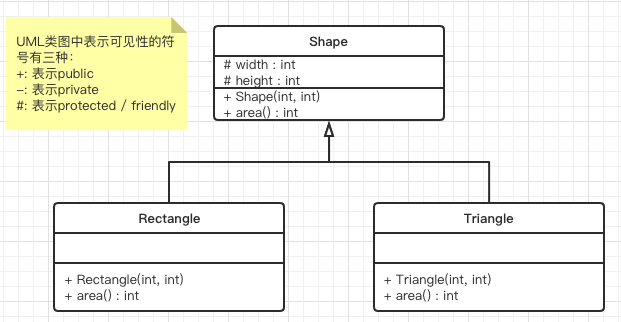C/C++ 语言系列(十)面向对象编程之继承与多态
继承
C++ 继承的语法如下,支持单继承和多继承:
1 | // Single inheritance 单继承 |
继承类型
继承类型通过访问修饰符 access_specifier 来指定:
| 继承类型 | 基类的 public 成员 |
基类的 protected 成员 |
基类的 private 成员 |
|---|---|---|---|
公有继承(public) |
派生类的 public 成员 |
派生类的 protected 成员 |
无法继承 |
保护继承(protected) |
派生类的 protected 成员 |
派生类的 protected 成员 |
无法继承 |
私有继承(private) |
派生类的 private 成员 |
派生类的 private 成员 |
无法继承 |
通常使用 public 继承,几乎不使用 protected 或 private 继承。
In principle, a publicly derived class inherits access to every member of a base class except:
- its constructors and its destructor
- its assignment operator members (operator=)
- its friends
- its private members
继承的访问控制属性
| Access | public |
protected |
private |
|---|---|---|---|
| members of the same class | yes | yes | yes |
| members of derived class | yes | yes | no |
| not members | yes | no | no |
构造、析构函数执行顺序
Even though access to the constructors and destructor of the base class is not inherited, they are automatically called by the constructors and destructor of the derived class.
Unless otherwise specified, the constructors of a derived class calls the default constructor of its base classes (i.e., the constructor taking no arguments).
继承后,执行顺序如下:
- 构造函数:先父后子
- 析构函数:先子后父
子类调用父类方法
BaseClass::Function()
多态
One of the key features of class inheritance is that a pointer to a derived class is type-compatible with a pointer to its base class. Polymorphism is the art of taking advantage of this simple but powerful and versatile feature.
类继承的关键特性之一,就是指向派生类的指针与指向其基类的指针在类型上兼容。 多态是利用这一简单但强大而通用的功能的艺术。
下面使用指针来演示多态这一特性。
UML 类图如下:

类声明如下:
1 | // pointers to base class |
使用方式一:
1 | int main() { |
使用方式二,参考:Dynamic memory
1 | int main() { |
描述如下:
Function
maindeclares two pointers toShape(namedp1andp2). These are assigned the addresses ofrectandtrgl, respectively, which are objects of typeRectangleandTriangle. Such assignments are valid, since bothRectangleandTriangleare classes derived fromShape.Dereferencing
p1andp2(withp1->andp2->) is valid and allows us to access the members of their pointed objects. For example, the following two statements would be equivalent in the previous example:
2
p1->area();
虚函数(virtual)
虚函数是在基类中使用 virtual 关键字声明的函数,是可以在派生类中重定义的成员函数。虚函数用于实现运行时多态:
1 | +--------------------+ |
派生类也可以重定义基类的非虚函数,但无法通过基类的引用来访问派生类的该函数。即:如果移除上述基类中 area 函数声明的 virtual 关键字,下面的函数调用将返回 0,因为实际调用的是基类的版本:
1 | cout << "rectangle area is " << p1->area() << endl; // rectangle area is 0 |
Therefore, essentially, what the
virtualkeyword does is to allow a member of a derived class with the same name as one in the base class to be appropriately called from a pointer, and more precisely when the type of the pointer is a pointer to the base class that is pointing to an object of the derived class, as in the above example.A class that declares or inherits a virtual function is called a polymorphic class.
注意,尽管成员之一是 virtual 的,但 Sharp 仍然是一个常规类,可以实例化对象。
纯虚函数(抽象类)
Classes that contain at least one pure virtual function are known as abstract base classes. The syntax of pure virtual function is to replace their definition by =0 (an equal sign and a zero):
1 | // abstract class CPolygon |
Abstract base classes cannot be used to instantiate objects:
1 | // 不允许使用抽象类类型 "Shape" 的对象: -- 函数 "Shape::area" 是纯虚函数 |
But an abstract base class is not totally useless. It can be used to create pointers to it, and take advantage of all its polymorphic abilities.
1 | // the following pointer declarations would be valid |
Virtual members and abstract classes grant C++ polymorphic characteristics, most useful for object-oriented projects.
C++ 接口是使用抽象类来实现的。